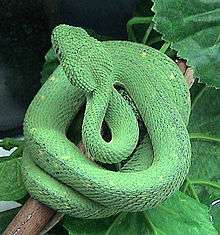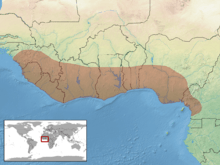Atheris chlorechis
Atheris chlorechis is a venomous viper species found only in the forests of West Africa.[3] No subspecies are currently recognized.[5]
| Atheris chlorechis | |
|---|---|
 | |
| Scientific classification | |
| Kingdom: | Animalia |
| Phylum: | Chordata |
| Class: | Reptilia |
| Order: | Squamata |
| Suborder: | Serpentes |
| Family: | Viperidae |
| Genus: | Atheris |
| Species: | A. chlorechis |
| Binomial name | |
| Atheris chlorechis (Pel, 1851) | |
 | |
| Synonyms | |
| |
Description
Adults average 50 cm (20 inches) in total length (body + tail), with a maximum total length of 70 cm (28 in). The tail is relatively long. The body is relatively slender, with 25-36 midbody rows of dorsal scales. These are heavily keeled, with the keels ending in a swelling at the end of each scale.[3]
Adults have a uniform light green ground color, overlaid with a series of faint yellow, roughly paired spots running dorsally along the length of the body and about 2.5 cm (about 1 in) apart. The belly is pale green in color.[3] Newborns are tan-brown in color, but this changes to a yellow-green hue with irregular dark spots within 24 hours.[6] This second color phase has been described as the reverse of that of the adults and is only seen in individuals less than 25 cm (9.8 in) in total length.[3][6]
Geographic range
West Africa including Guinea-Bissau, Guinea, Sierra Leone, Liberia, Ivory Coast, Ghana, Togo, Benin, isolated locations in Nigeria, Cameroon, Equatorial Guinea and Gabon.
The type locality is listed as "Boutre, Ghana".[2]
Habitat
Found in forests, in dense foliage about 1–2 m (about 3–6 ft) above the ground.[3]
Feeding
Said to feed on rodents, lizards and tree frogs.[3]
Reproduction
Gives birth to 6-9 young in March to April. Newborns are 131–151 mm (about 5-6 inches) in total length.[6]
References
- Penner, J., Luiselli, L., Rödel , M.-O., Segniagbeto, G. & Joger, U. 2013. Atheris chlorechis. The IUCN Red List of Threatened Species 2013: e.T178495A18189511. https://dx.doi.org/10.2305/IUCN.UK.2013-1.RLTS.T178495A18189511.en. Retrieved 30 October 2018.
- McDiarmid RW, Campbell JA, Touré T. 1999. Snake Species of the World: A Taxonomic and Geographic Reference, Volume 1. Washington, District of Columbia: Herpetologists' League. 511 pp. ISBN 1-893777-00-6 (series). ISBN 1-893777-01-4 (volume).
- Mallow D, Ludwig D, Nilson G. 2003. True Vipers: Natural History and Toxinology of Old World Vipers. Malabar, Florida: Krieger Publishing Company. 359 pp. ISBN 0-89464-877-2.
- Mehrtens JM. 1987. Living Snakes of the World in Color. New York: Sterling Publishers. 480 pp. ISBN 0-8069-6460-X.
- "Atheris chlorechis". Integrated Taxonomic Information System. Retrieved 23 August 2006.
- Spawls S, Branch B. 1995. The Dangerous Snakes of Africa. Ralph Curtis Books. Dubai: Oriental Press. 192 pp. ISBN 0-88359-029-8.
- Brown JH. 1973. Toxicology and Pharmacology of Venoms from Poisonous Snakes. Springfield, Illinois: Charles C. Thomas. 184 pp. LCCCN 73-229. ISBN 0-398-02808-7.
Further reading
- Boulenger GA. 1896. Catalogue of the Snakes in the British Museum (Natural History). Volume III., Containing the...Viperidæ. London: Trustees of the British Museum (Natural History). (Taylor and Francis, printers.) xiv + 727 pp. + Plates I.- XXV. (Atheris chlorechis, pp. 508–509.)
- Cansdale GS. 1961. West African Snakes. London: Longman's. 96 pp. ISBN 058260849X.
- Pel, H.S. (1851). "Over de jagt aan de Goudkust, volgens eene tienjarige eigene ondervinding". Nederlands Tijdschrift Jagtkunde. 1: 149–173. (Vipera chlorechis)
External links
| Wikimedia Commons has media related to Atheris chlorechis. |
- Atheris chlorechis at the Reptarium.cz Reptile Database. Accessed 8 September 2007.
- Atheris chlorechis at The World Of Atheris. Accessed 8 September 2007.
